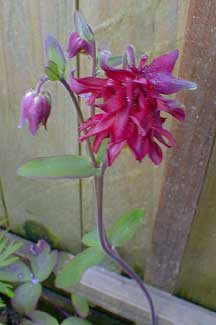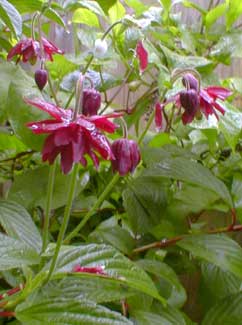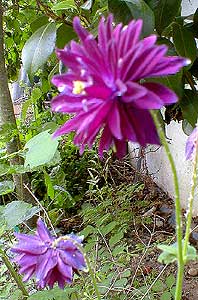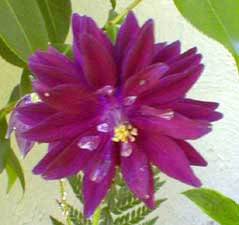
'Ruby Port' Double Columbine
and the Symbolism of the Dove
"The columbines have overrun all bounds."
-Amy Lowell,
1874-1925
1874-1925
The first photo shows Aquilegia vulgaris plena 'Ruby Port' in April, growing close to a fence in a shady location near a European Monkshood. In April, the foliage was still just getting started, but already the tiny clump was sending up stems full of flowers to two-foot high or so. It continued blooming right up to July, then had pleasing ferny foliage well into autumn.
But it was a little more hidden than I had expected, but I hated to disrupt it after it was good & going. So a year later I planted a second one in the center of a little primula garden in the shade of a Dawn Viburnum. The second clump's flowers are shown in the May photo below.
 To call its blossoms fully double is an understatement; each nodding flower has as many of four singles tucked one inside another, but as there is no catagory "quadruple," doubles they are.
To call its blossoms fully double is an understatement; each nodding flower has as many of four singles tucked one inside another, but as there is no catagory "quadruple," doubles they are.This variety has gorgeous wine-red flowers with small yellow stamens. The soft foliage is almost a match for the flower in that it emerges burgundy-maroon, aging to blue-green. With its winter die-back, it completely disappears, but returns to our garden at mid-February, the first glimpse of it being the burgundy-colored budding leaves. Extremely cold-hardy, it will not reappear nearly so early in colder zones, waiting for the first & merest hint of spring.
'Ruby Port' is an heirloom variety & dates to 1600 in monastery gardens. Even so, for a couple of centuries it was something of a rarity, naturalized in a few antique gardens. When after a long absence it was rediscovered & reintroduced to modern gardening, it was soon a most popular variety.
 | |
| Columbine cultivars are constantly cross-fertilizing in the garden, so when they self-seed, they are rarely if ever true in form to whichever parent cast the seeds. This one, shown in June, erupted on its own in a garden previously devoid of double-columbines. The flower resembles 'Ruby Port' which probably seeded it, but the pompoms are a bit more purple than red, & are twice as big as 'Ruby Port.' So I call it 'Giant Ruby Port.' The fourth photo (below right) shows a bloom from the same clump. | |
Because "Holy Spirit" whether spoken in Hebrew, Aramaic, or Greek is a feminine name, it was by mystical Christians regarded as the Mother-figure of the trinity, Father, Son, & Mother. In Hebrew Ruach, Spirit, is a feminine word realistically read "Mother-spirit," & in Greek Pneuma has the same connotation. Doves being androngynous in appearance & behavior, they were in ancient times thought to consist exclusively of females that reproduced without need of males. The myth of the goddess Agdistis impregnating the River-nymph Nana with an almond, so that she gave birth to the savior Attis, is in essence the same story told of the Holy Spirit impregnating the Virgin Mary.
In classical Eastern Orthodoxy, the Dove thus represents the Divine Sophia. The Orthodox Christian father Aphraates of the fourth century quite properly called the Holy Spirit the Mother of humanity [Homily 28:10], & the vast majority of early Gnostics agreed. Both Origen & Jerome quote from the Gospel of the Hebrews, wherein Jesus claimed, "My Mother the Holy Spirit took me by one of my hairs and carried me to the great Mount Taber," paraphrasing Mt 4:1 and Lk 4:1-2. Occasionally Mary herself was associated with columbines but in general only blue columbines indicate Mary, as her veil or shawl is traditionally believed to have been blue.
 If all Christians were to read their scriptures with an understanding that all references to the Holy Spirit, or to the Dove, represent God's Bride, an otherwise very bizarre "extra god" in the trinity would at long last make sense, being as she is the submerged Goddess thereby worshipped in many a religious household without their even knowing it. Frankly, I'd think even the looniest fundamentalist would have already thought that Father, co-Father, & Son, never made a lick of sense, unless their gynophobia really that greatly outweighs their homophobia.
If all Christians were to read their scriptures with an understanding that all references to the Holy Spirit, or to the Dove, represent God's Bride, an otherwise very bizarre "extra god" in the trinity would at long last make sense, being as she is the submerged Goddess thereby worshipped in many a religious household without their even knowing it. Frankly, I'd think even the looniest fundamentalist would have already thought that Father, co-Father, & Son, never made a lick of sense, unless their gynophobia really that greatly outweighs their homophobia.She is of course the equivalent of the Divine Shekhinah, or Kallah the Bride of mystical Judaism. In Jewish iconography a dove, or a female angel, is shown above a marriage-canopy blessing the marriage. This is the Shekhinah, Feminine Presence of God. Jewish & Christian myths frequently incorporate the most overt elements of the Great Mother with surprising abandon.
In a fragment of the book of Elchasai preserved by Hippolytus, it was taught among Christians that the Holy Spirit had the form of a woman ninety-six miles tall. An equivalent Jewish teaching encountered in the Holy Zohar of Safed describes the Shekhinah as a giantess whose feet reach down into Sheol, whose head is crowned by the Moon; & from between her legs issues her son, Metatron, a warlike archangel himself a giant, even though he is dwarfed by the Shekhinah, Mother of Angels.
Such symbolism was of course inherited by modern religions from the worship of Cybele & Aphrodite, to whom the dove was particularly sacred. In early Hittite pictographs, Cybele's name was written with a series of drawings, including a Dove; & in Rome, Columba, the Dove, was sacred to Venus & Magna Mater, & could herself take on the goddess form of Columbia.
That the fiery red Columbine in particularly was emblematic of Cybele long before it was the Fiery Dove of Pentacost was in part because the Dove also signified descent from heaven in the form of a fiery meteor, & meteorites were commonly kept in temples of Cybele. Among medieval alchemists or sorcerers, red columbines were called "Venus Plants," & used in concocting love philtres.
So this association of Columbines with Doves is ancient, & Anglo-Saxons called them Culverworts, i.e., Pigeons' Herbs. Curiously its Latin name Aquilegia is the opposite of Dove-like, meaning instead Eagle, because columbines have five spurs resembling eagle talons, though on double-flowering varieties of columbines, such as 'Ruby Port,' the eagle-spurs blend amidst petals to give more of a pompom appearance very different from the distinctively shaped singles.
Simultaneous Eagle & Dove symbolism again plays into the alchemical philosophy of transformation into opposites, evil into good, lead into gold, folly into wisdom, or the warlike eagle into the peaceful dove. In kabbalah, this can even indicate the transformation of Lilith into the Shekhinah.
Continue to the species columbine:
Aquilegia alpina